
Introduction
The digital learning landscape of 2024 is in a state of flux, evolving rapidly in response to the changing world. The imperative for innovation and agility has never been more pressing.
That’s where Learning and Development (L&D) comes in.
In this era of constant change, how are L&D teams adapting their strategies? What role does technology play, and how can it be balanced with a focus on human-centric learning experiences? Furthermore, how are collaboration and practical steps shaping the future of L&D?
The State of Digital Learning Report sets out to explore what’s next.
Our data
This report brings together the views of L&D leaders, experts who shape learning experiences, and the employees who engage with learning. We gathered data and insights from:
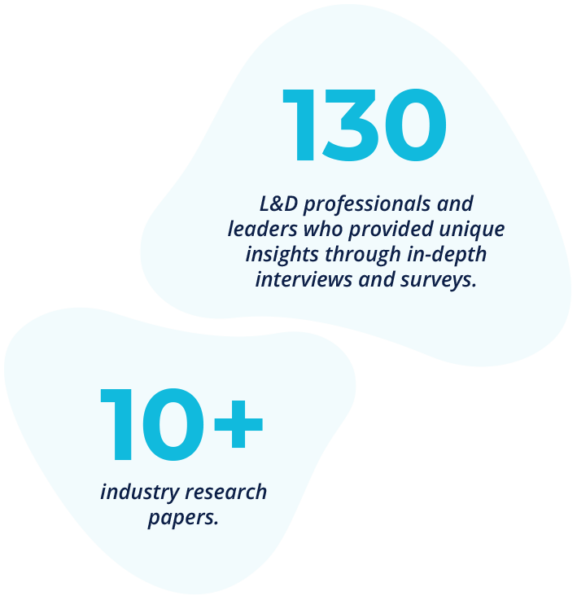
We surveyed L&D managers & leaders in organizations with over 1000 employees in North America & Europe. We also conducted 12 in-depth interviews with learning experts from some of the world’s biggest organizations.
Our findings
We’ve taken the results of this year’s research, compared answers from last year’s report and distilled it down into key findings across three focus areas.
Current challenges
Explore the critical factors that exacerbate existing issues and create new L&D challenges.
Shifting learner needs
Discover how future-focused L&D teams are trying out new ways of doing things to overcome their challenges and meet business and employee needs.
Practical steps to get started
Uncover the key ways you can get ready for the year ahead and maximize your impact in 2024.
Share the key findings from this report with your team [Infographic]
Join the 10% of L&D professionals who are ready for 2024’s challenges. Discover the essential strategies your team needs to meet your learners’ expectations with this handy infographic.
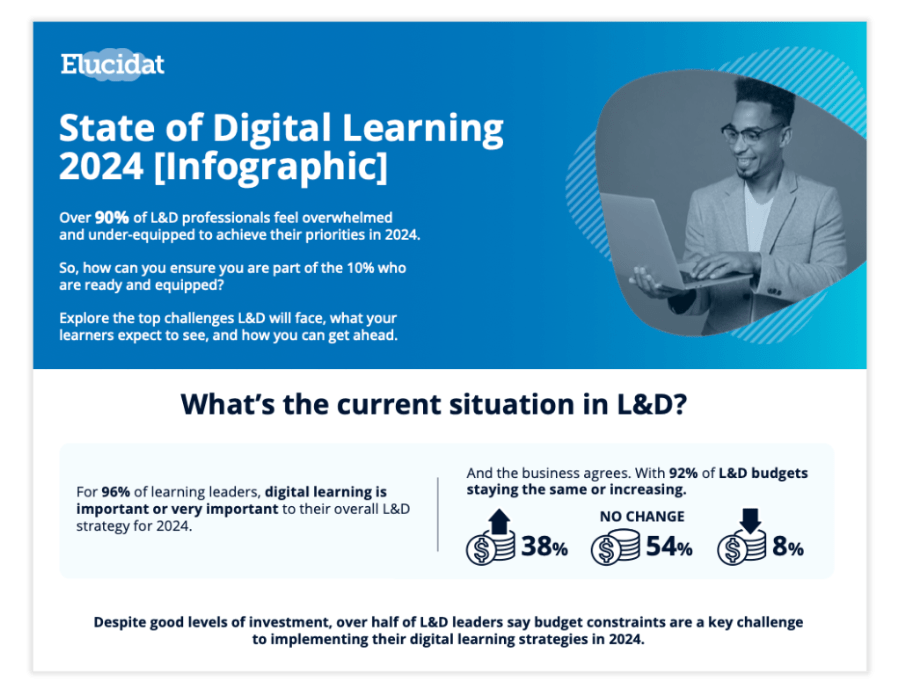
Chapter 1
Current challenges facing L&D
Last year’s report saw L&D teams being asked to do more than ever before. Finally seen as business critical, learning leaders had never been so in demand… but is that still the case?
From the rapid adoption of new technologies to increasing economic uncertainty, business needs are still changing at an accelerated pace. But while everything else is in flux, one thing’s for sure. L&D is critical if everyone is going to keep up.
Of course, that’s easier said than done. Delivering effective learning at speed and scale isn’t straightforward. So, what might stop you from having the impact you need in 2024?
Let’s find out what challenges L&D professionals and experts are currently coming up against.
What do your peers in L&D think?
We surveyed L&D leaders working in enterprise organizations across the world to explore their key challenges.
What’s the current situation in L&D?
For 96% of learning leaders, digital learning is important or very important to their overall L&D strategy for 2024.
And the business agrees. With 92% of L&D budgets staying the same or increasing.

What are the top priorities for L&D teams in 2024?
With budgets appearing stable, the key question now is: where will Learning and Development (L&D) concentrate their efforts for maximum effectiveness?
- 63% need to improve quality and engagement
- 20% want to increase capacity to scale up and respond quicker
- 12% aim to improve collaboration with experts across their business
What challenges do L&D face?
Despite good levels of investment, over half of L&D leaders say budget constraints are a key challenge to implementing their digital learning strategies in 2024.
90% feel overwhelmed and under-equipped to achieve their priorities – a significant increase from last year.
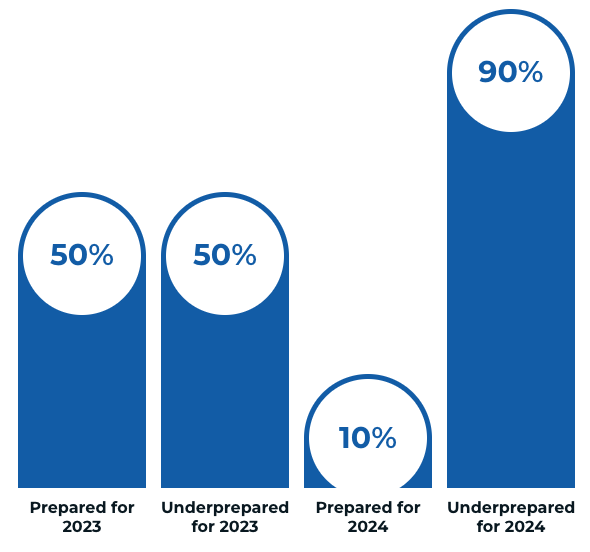
While organizations clearly value and invest in their people’s development, L&D teams don’t feel this is enough for them to have the required impact.
Here are just some of the top challenges facing L&D in 2024.
- Budget constraints
- Lack of capacity
- L&D skill gaps
- Technical limitations
- Resistance to change
Struggling with their capacity and capabilities, L&D teams don’t feel they’re a match for the big organizational changes they need to drive forward. This shows up in a number of ways.
What’s not working?
L&D professionals highlighted what they feel hasn’t worked over the last year.

Content issues were seen as a major factor in reducing L&D’s impact.
Critical problems include:
- Digital learning lacking engagement
- Content overload
- Learning lacking relevance
“We’re struggling to increase engagement, and therefore retention, with our content.”
– Survey respondent
“Our role is to signpost to key learnings but everyone’s getting lost in the enormity of everything.”
– Survey respondent
“We have libraries of content with no clear context or goal and no link to employee’s careers.’’
– Survey respondent
L&D processes aren’t fit for purpose in the new world of constant, fast-paced change.
From needs analysis through content creation to measuring success, a number of pain points were highlighted.
“We’re struggling to understand the business priorities and aligning these to user needs.’’
– Survey respondent
‘’Learning content takes too long to develop and becomes irrelevant quickly.’’
– Survey respondent
‘’We need a strategy for Return On Investment (ROI).’’
– Survey respondent
People factors were mentioned by several L&D professionals.
Key struggles include:
- Lack of motivation
- Screen time fatigue
- Resistance to change
“Digital learning relies on the interest of the employees and we sometimes take it for granted.’’
– Survey respondent
“For many learners, the biggest challenge is the struggle with focusing on the screen for long periods of time.’’
– Survey respondent
“We’re struggling to convince the nay-sayers… A single employee who has access to a wealth of information can act as a roadblock towards development.’’
– Survey respondent
Technology limitations are also hampering L&D’s impact.
This includes:
- Outdated and ineffective learning technology
- Issues integrating systems
- Difficulties accessing learning in the flow of work
‘’Our tech is too basic.”
– Survey respondent
‘’Authoring tools are limited in functionality.’’
– Survey respondent
‘’Importing from existing/legacy systems isn’t working well.’’
– Survey respondent
‘’We lack a mobile platform our frontline teams need.’’
– Survey respondent
What do the experts think?
Armed with these insights from the frontline of L&D, we reached out to some leading L&D experts to get their perspectives. Here are their thoughts on the key challenges for 2024.
Technology
There’s been no escape from Artificial Intelligence (AI) this year. 2023 saw both businesses and L&D experimenting with this new technology. 2024 is when things get real. Finding effective and ethical ways to use these tools is critical for success in 2024.
“AI introduces new risks that require thoughtful and effective responses — which includes educating employees. Companies are being required to weigh the benefits of AI against the risks and then articulate clear standards in areas like: Information accuracy and bias (Is this content correct and unbiased?); Privacy and information security (What is AI collecting, where is it stored and protected, can it be reused?); and intellectual property (Could AI-generated information include someone else’s IP?).”
– Kirsten Liston, Founder and CEO, Rethink Compliance
‘’It’s a hot topic and a lot of excitement and enthusiasm is – quite rightly – focused on the benefits of AI. Whilst tools like Google Bard and ChatGPT are getting a lot of the attention right now, L&D teams are going to have to spend time thinking about how similar tools can be embedded into their learning ecosystem. I see a debate on data and ownership. Would a fully personalized learning experience that’s shaped around user data be something that everyone wants to commit to if it means other colleagues seeing their data.’’
– Lloyd Dean, Global Learning and Development Manager, AXA
People
The new normal of remote and hybrid working has had time to settle. Whether you call it Zoom fatigue or digital burnout, it’s clear that there are some issues. Providing more online learning won’t necessarily lead to greater engagement or impact. In fact, it can lead to the opposite effect.
‘’Exponential change, including change to our work environments, means the human story matters more than ever. Everyone’s grappling with tech advancements, the need to upskill, reskill, shifts in company strategy and restructures. We need to help people orientate (constantly), understand the context for these shifts and what it means to them.’’
– Cheryl Clemons, CEO, Storytagger
‘’Most companies are looking for ways to make learning accessible at all times from everywhere. This is good but we’re experimenting with a slightly different approach. The workforce is becoming more expectant about the delineation between work and home, even if the office is in the same location. It’s about carving out time for learning and practice within the workday, not as an after-hours add-on.’’
– Lori Niles-Hoffmann, Senior Learning EdTech Transformation Strategist, NilesNolen
L&D capabilities and process
From AI and data analysis to change management and employee engagement, L&D is getting involved in more strategic conversations than ever. This means developing new capabilities and collaborative ways of working.
‘’Let’s not pretend we’re jumping from zero to AI fluency. Let’s start with data literacy to speak the language of impact! Then we can apply analytics to tell the story of the impact in a meaningful way that makes a difference (beyond just to be correct). Finally, I believe we shouldn’t just focus on “learning analytics” in the sandbox just because we have full control over the sand. Let’s get messy! Learning without application on the job is a waste. No matter how we tell the story.’’
– Zsolt Olah, Senior Learning Technologist, Amazon
‘’As AI becomes more integrated into our content creation and productivity tools, there will be more “human-in-the loop” or even “community-in-the-loop” similar to the socio-technical theory whereby humans are complementary to the machine and it is focused on collaboration and co-creation of different learning events, activities, and performance support. Different kinds of learning expertise will emerge, perhaps ones that are oriented towards fact-checking, quality control, and analysis of qualitative data.’’
– Stella Lee, Director, Paradox Learning
The pressure is on. Tasked with driving forward big organizational change, many teams feel they lack the capacity and capabilities to deliver. We’ve discovered that this is showing up in three key areas of challenge: technology, people, and processes.
How is this filtering down to the end user? Let’s turn our attention to the learners.
Chapter 2
Shifting learner needs
L&D aren’t the only people under pressure. Everyone is feeling it. While new tech is transforming the way we work, day-to-day tasks still need to be completed and deadlines met. With financial uncertainty and home pressures added to the mix, a lot is competing for peoples’ attention.
In this challenging business landscape, how do you keep your employees engaged and developing?
Let’s start by figuring out more about the people at the center of your work: the learners. With a clearer picture of what they want, we’ll explore some of the ways your peers are adapting to meet these shifting learner needs.
What do modern enterprise learners want?
We surveyed employees in enterprise organizations to explore how they engage with learning in a global, corporate environment. Here’s what we found.
Accessing learning
Digital learning is an increasingly regular part of all employees’ lives. Last year, people were accessing learning every month and quarter. Now, it’s becoming a more daily and weekly commitment.
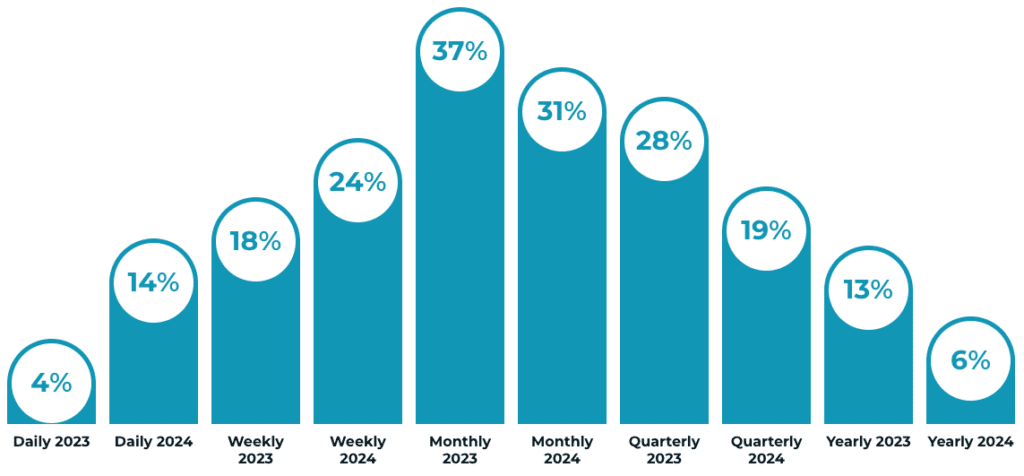
Although there’s been a rise in employees completing digital learning at home, usually on a desktop or laptop, this generally happens during working hours.

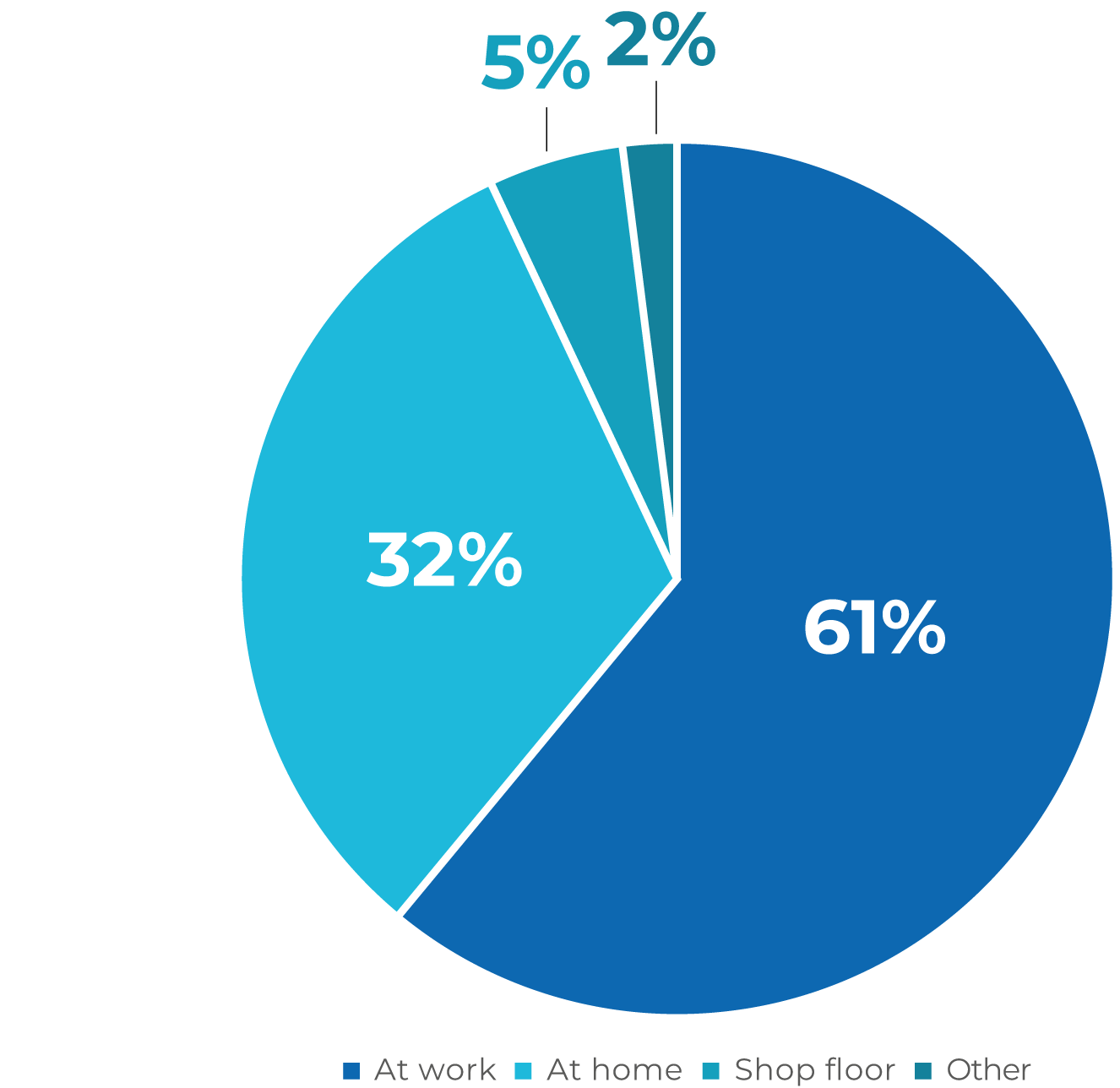
The days of squeezing elearning into a commute, lunch break, or evening are well and truly behind us. L&D needs to respect their learners’ time. And that means delivering effective learning that’s easy to fit around people’s day-to-day work.
Meeting needs
82% of people are more likely to stay at a company if it invests in their professional development.
However, around a third of employees feel that their digital learning does not align, or only partially aligns, with the company’s overall goals and objectives.
Employees know which skills will most help them in their work – Tech takes the lead with a big increase (+17%) from 2023.
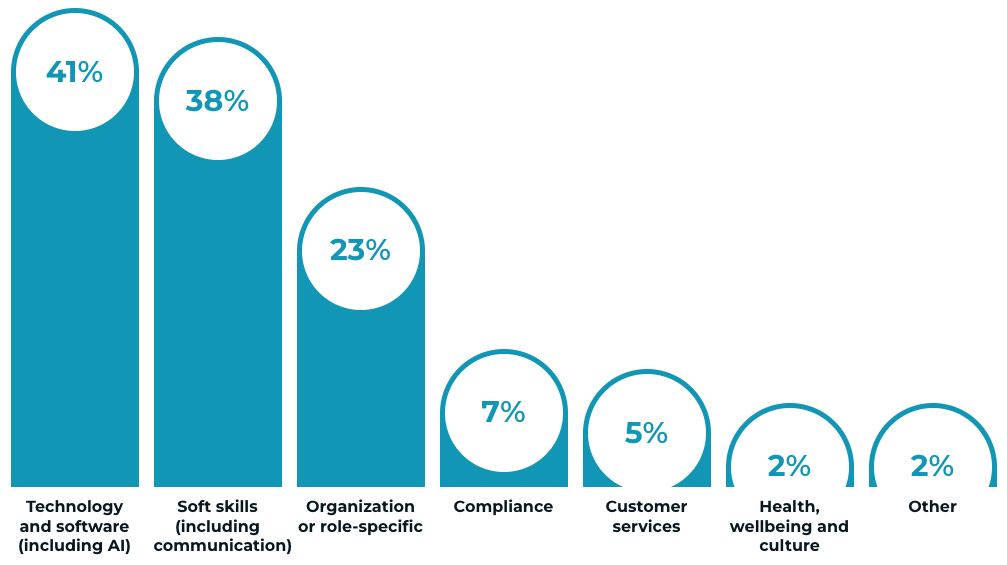
Yet 45% of employees have not been provided with learning on these skills over the last six months. L&D has made big strides to make it easier for employees to find online courses or resources within their organization
0 Very easy to find 0 Somewhat easy to find 0 Difficult to find 0Very difficult to find
But this may not be enough. When employees have a learning need, they’re increasingly looking to Google for an answer. And this is only going to increase as younger people join the workforce. For 64% of 18 to 24-year-olds, using Google or a Chatbot is the first choice for their learning needs.

Providing quality learning experiences
L&D need to do more to ensure the learning they provide is what employees want and need. Current learning content isn’t hitting the mark. It’s taking too long, lacking impact, and failing to meet expectations.
In 2023, 50% of employees in large organizations rated their elearning as fair to poor. This year that’s jumped up to 60%. Recent efforts are clearly falling flat. So, what needs to change?
Relevance
Over a third of learners were more engaged when elearning could easily be applied in their work.
However, over 60% feel that the digital learning provided by their organization is not relevant to their role. Faced with rapidly changing skills requirements, L&D needs to find new ways to personalize content that works at speed and scale.
“Digital learning doesn’t work for me when it’s just doing something for the sake of it. Time is very precious!”
– Survey respondent
‘’Make [content] relevant and on point to you so that you can use it in the job, in the real world, as quickly as possible.”
– Cammy Bean, Senior Solutions Consultant, Kineo
Ease
A quarter of learners said their engagement increased when learning was easy to access, understand, and use at the point of need.
Digital learning may be easier than ever to access, but if L&D wants to stay in control and maintain quality, it needs to compete with the effortless experience of unofficial sources of learning, like Google and AI.
“When elearning works it’s smooth and efficient – with no trouble at all. It should be user friendly.”
– Survey respondent
‘’There were people coming in and not feeling supported in their experience in their first year of being with us. And that just felt completely wrong … So now we’ve got some tools and templates that support people. We’ve got SharePoint sites that they can easily go to and get information from. We’ve got communications that are reminding them of what’s available. It’s just been a really great experience to bring that to life.”
– Melanie Lepine, Global Onboarding Lead, CBRE
Quality
About a quarter of employees said their engagement increases when elearning is interactive. And they’re clear that this doesn’t mean more clicking onscreen. It’s about having an opportunity to reflect on their knowledge and apply their skills.
These strategies for maintaining learner engagement and knowledge retention aren’t new. L&D needs to refocus its effort on maintaining the quality of its content.
“Elearning keeps my interest when it’s an interactive learning experience with tests to check your absorption of the information.”
– Survey respondent
‘’Capturing human attention is as challenging as it has ever been, and the competition for airtime has increased substantially. Our strategy is simple: Make great content and make it only as long as it needs to be.’’
– Kirsten Liston, Founder and CEO, Rethink Compliance
Want to explore some ways you can deliver impactful elearning?
Whether you call yourself a learning designer or performance consultant, an accidental instructional designer or a subject-expert, you’ll find what you need to design effective online learning solutions in our elearning best practice guide. Access the guide by clicking below.
What can L&D do to meet these shifting needs?
The modern enterprise learner doesn’t want to waste their time with ineffective elearning. But providing up-to-date, relevant content isn’t easy when business needs are shifting and new skill gaps are emerging every day. That’s why L&D professionals are looking for new tools, and tried and tested techniques to develop digital learning experiences with impact.
Technology
Just as employees turn to AI to help them at work, L&D teams have also explored new technologies in 2023. This looks to increase in 2024, with 86% of L&D teams considering using AI to assist with their digital learning initiatives.
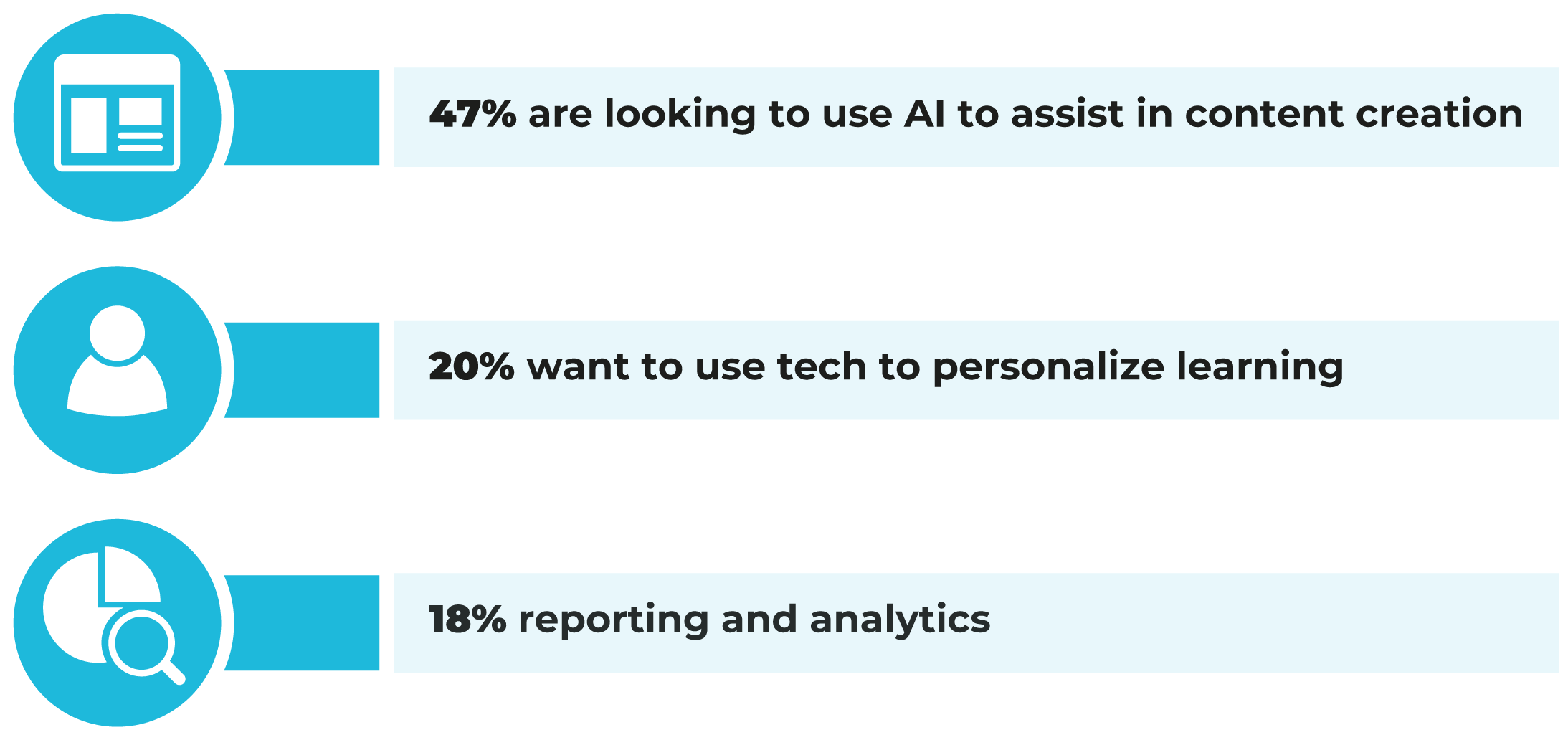
Of course, tech alone won’t deliver impact. You need to focus on the objective – helping employees develop the skills they need. Think strategically about how these tools can be embedded in the L&D lifecycle.
Here’s what the learning experts think you should be focusing on.
“As AI-enabled technology becomes commonplace, more data points will be available to collect, review, and interpret. Not only is AI introducing new tools for data analytics, but also processing large volumes of historical and disjointed learning data. What measures count the most [depend on] what you’re trying to achieve or what questions you need answers for…It’s not just consuming the information from a learning platform dashboard without critically analyzing the reasons and cross-referencing other factors influencing learning.”
– Stella Lee, Director, Paradox Learning
‘’L&D teams are going to have to spend time thinking about how AI tools can be embedded into their learning ecosystem…I also think that we’re coming to a potential existential question for L&D teams in the medium term. The capabilities we have today might not be needed tomorrow. It’s going to take focus and strategic thinking to move beyond that and find equilibrium.’’
– Lloyd Dean, Global Learning and Development Manager, AXA
People
The dominance of remote learning and the rise of AI all increase the risk of losing the human element that’s so critical for impactful learning. Yet, according to Fosway’s Digital Learning Realities report, the delivery of online social learning and performance support was basic. Only 27% of L&D teams we surveyed said that flexible blended learning, including both elearning and social elements, was working well in 2023.
So, how can we build on this in 2024?
Put humans at the heart
Understand your organization’s values. These need to be at the center of your learning ecosystem to be effective.
‘’You see technologies [being considered] when we think about attracting the future workforce…You need to understand the environment, the culture of the organization, before you can say these technologies are in line with the values and the vision of the company of the future.”
– Katja Schipperheijn, Learning strategist, consultant, author, and keynote speaker
Harness internal expertise
You can’t create a new learning landscape alone. Get your stakeholders aligned. Work in collaboration with other departments. Empower organization-wide involvement in learning.
‘’Human connection matters. Real relatable stories, examples of how learning has helped people overcome challenges, and grow their career are not only important to engagement but also learning transfer…The ability to use organization-specific knowledge [with new tech] is a game-changer too as this should help fight generic, over-reductive content and experiences. Ignore human skills at our peril!’’
– Cheryl Clemons, CEO, Storytagger
Capture experience to create context
Capture your organization’s tacit knowledge, experience, and stories. Provide the context your people need to put their learning into practice at work.
‘The same strategies for maintaining learner engagement and knowledge retention apply in the new order of remote and hybrid work environments as they did in the old office world: make sure content is contextualized and relevant – so people see themselves in the experience and understand how this knowledge or skill applies to their work. Remote vs. hybrid shouldn’t change the principles of good learning design. It’s still got to be about people.’’
– Cammy Bean, Senior Solutions Consultant, Kineo
L&D ways of working
In 2023, LinkedIn highlighted that businesses required agility. In 2024, this is still critical. As technology evolves and new skill gaps emerge, L&D needs to respond at pace. There’s no point in spending months developing digital learning if things have moved on by the time you deliver it.
Around a fifth of L&D teams highlighted that effective collaboration helped them respond to business needs in 2023. Embracing new collaborative models and methods will be critical to delivering impact at speed and scale in 2024.
Where can collaboration be increased in digital learning production?
- Needs analysis
Whether it’s key business stakeholders or Subject Matter Experts (SMEs), you can’t understand your business and employee needs alone. Get people involved in the conversation. Ask lots of questions. Make connections. Be ready to learn.
Find out how you can capture needs effectively in our needs analysis template. - Content creation
Internal experts have always been essential to an organization’s learning and development success. They know the subject matter inside out. They have the experience that needs to be shared. They understand what’s really relevant to learners. But they can be much more than just a gateway to content and audience. With the right tools and support, they can create quality learning content.
For tips on how you can achieve this, check out our guide to setting up SMEs for success. - Continual improvement
Use collaborative and iterative ways of working. Involve your SMEs, stakeholders, and especially your end users so you’re more likely to hit their target. Explore the data and analytics your tool offers together to tweak and enhance your elearning along the way and deliver more impact.
Explore ways to improve L&D at your organization in our guide to using data to cultivate effective elearning.
Collaborative success stories
So what does this look like in practice? Looking to increase the speed and scale of their work, two L&D teams working in very different industries have embraced new collaborative ways of working.
Here are their stories to get you inspired.
Max Mara maintaining standards at scale
As one of the world’s most prestigious international fashion brands, quality output is critical to Max Mara. So, when they had to scale up their elearning production, standards needed to be maintained.
With the right authoring tool and some upfront effort, the team was able to onboard new authors quickly. In no time, they were producing inspiring learning experiences to meet the needs of an international audience working across 10 different brands.

The results
- Delivering learning to 10,000+ employees
- Across 10 brands
- In 10 languages
Want to find out more? Explore Max Mara’s full story.
“I think that the proudest achievement I can talk about is the fact that every person on the team that works with Elucidat is completely autonomous.”
– Beatrice Cocchi, Corporate HRM Learning Coordinator,Max Mara Fashion Group
Oxfam’s democratized approach
With 9,000 employees working in 87 countries to support people on the ground, Oxfam knows the importance of knowledge sharing. The move to digital learning alone wasn’t going to enable them to respond to fast-changing international developments.
To respond at speed and scale, Oxfam developed a democratized approach that empowered their Subject Matter Experts (SMEs) to create, update, and translate effective online learning.
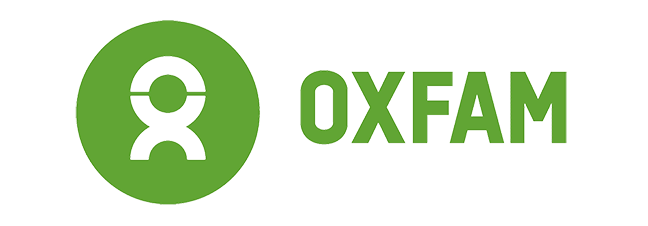
The results
- 130+ authors
- Across 87 countries
- Delivering learning to 9,000 employees (+ partners)
Learn more about this collaborative approach in our interview with three people playing an important role in Oxfam’s L&D.
“What Elucidat has done is empowered our Subject Matter Experts (SMEs) so they can create really engaging online learning’’
– Jo Grantham, Training Lead, Oxfam
Chapter 3
Practical steps to stay ahead in 2024
The challenges L&D are facing also present an opportunity to explore new ways of working that can deliver more impact. Some forward-thinking L&D teams are already embracing new collaborative approaches. What could this look like for you in 2024?
Find out what other L&D professionals and experts see as the top L&D trends for 2024.
3 things L&D teams are doing to deliver impact
1. Embracing new technology
73% of learning professionals think new technologies will be shaping the future of digital learning. And AI is overwhelmingly the top tool.
But remember, tech alone won’t solve your problems. Bring your organization’s knowledge and technology together in an efficient learning ecosystem.
Let’s take a look at the new technology L&D professionals will be embracing this year.
“AI isn’t replacing any of the roles that I’ve ever been in in L&D. I still have those technical knowledge requirements. I still need to review all of my content for accuracy. Instead of thinking about it as in competition for your job, we just need to see it as an enhancement or an accelerator.”
– Angie Elliott, Manager of Sales Enablement and Talent Development, Hormel Foods
2. Focusing on your people
From culture and collaboration to wellbeing and work/life balance, 46% see L&D shifting towards a more people-centered approach. There isn’t one right way to do this. But here are the top 5 learning approaches your L&D peers are looking to use in 2024 to better meet their people’s needs.
- #1 Personalization
- #2 Microlearning
- #3 Blended learning
- #4 Learning in the flow of work
- #5 Social learning
3. Developing new ways of working
To make the most of advances in digital technology and use it to deliver genuinely people-centered digital learning, L&D needs to take a new approach. 18% of learning professionals expect to see new L&D skills and working methods being developed in 2024.
Let’s take a look at the top methods L&D professionals will be investing in this year.
‘’The urgency is in L&D themselves taking the lead. Don’t wait until you get a question from the business. Become the strategic advisor…Go to your departments, like marketing. They have a lot of knowledge of how to influence people to change their behavior…Go to the people from IT. Work together. I think breaking down the silos and working together as a strategic office for the future, that’s what we need right now.”
– Katja Schipperheijn, Learning strategist, consultant, author, and keynote speaker
5 technology driven trends
As we move from experimentation to real-world use, the impact of new technologies will be far-reaching. Our L&D experts see five key trends being driven by this technological disruption.
“We had a great L&D year in the AI playground in 2023. All our problems are solved in pretend play! Now, let’s get messy and see how we can use AI for real. I do hope 2024 is finally the year when we stop creating content and start making an impact.
– Zsolt Olah, Senior Learning Technologist, Amazon
1. Experimenting with new ways of working
AI is going to be a game changer for L&D. Transforming everything from your ways of working to your learner experience. Stay agile, experiment, and find out how things work best at your organization.
‘’AI will impact us from 360 degrees. It’s going to change our workflows – how we do the work of L&D – and it’s going to change the experiences we deliver to learners – our output.’
– Cammy Bean, Senior Solutions Consultant, Kineo
2. Using data to feed into outcomes
AI doesn’t just present opportunities to speed up content creation. It offers a whole new world of data analysis. Choose the right metrics. Learn from the results. Transform your learning outcomes.
‘’I’m most excited about the ways data can be triangulated at scale to really understand what design and experience feed into outcomes. This will hopefully spell the end of SCORM and a better format for digesting the rich suspended data generated by personalized learning experiences.’’
– Lori Niles-Hoffmann, Senior Learning EdTech Transformation Strategist, NilesNolen
3. Reskilling for employees and L&D
The skill landscape has been evolving just as quickly as technology. Understanding how your organization wants to use AI is key to choosing the right upskilling or reskilling approaches.
‘’I anticipate a significant push towards upskilling and reskilling, driven by rapidly changing skill requirements brought about by AI…Above all, there’s an immediate need for AI literacy. It’s essential for the workforce to comprehend both the potential and the limitations of AI. This understanding will be foundational in determining the specific areas where upskilling and reskilling are most necessary.’’
– Stella Lee, Director, Paradox Learning
4. Staying on top of changing expectations
As people get used to quick, easy, and effective learning experiences with AI, their ideas of what learning could be will change. Understand and meet these expectations or risk learners switching off.
“I think AI is going to increase the expectations of the L&D teams. If the business are piloting AI tools for operational tasks yet the L&D team are offering 4-hour learning pathways I think there’s going to be an issue as the expectation of what learning could look like shifts.’’
– Lloyd Dean, Global Learning and Development Manager, AXA
5. Managing change through human connection
Like any big change, this technological transformation needs to be managed. People don’t just need to develop new skills. They need to buy into the benefits AI will bring.
‘’I think we’re ready for some nuance now around how AI gets deployed. Let’s not neglect the cultural, human and embedding aspects which need to be part of any technological transformation. AI has already been elevated to a business-wide strategy in many organizations so L&D will need to plug into this larger, intentional plan whilst applying it to their own goals. This will in turn create more change and people will need to be taken on the journey. It’s not just about the early adopters. Human storytelling will be a key thread to help this change land well.’’
– Cheryl Clemons, CEO, Storytagger
2024 is looking to be another year of disruption. This change can’t be avoided. But it won’t just present challenges, it will offer lots of opportunities to find new and better ways of working. This includes transforming your learning through data analysis, anticipating and bridging skill gaps, and meeting shifting expectations.
Which tech-driven trends are you ready to embrace?
Conclusion
Putting it into action
Meeting fast-changing business needs with practical digital learning experiences is critical to L&D’s success in 2024. Responding at speed and scale while maintaining quality requires new ways of doing things.
L&D professionals and experts highlighted three strategies that will help you drive effective learning at an enterprise scale.
- Use technology strategically
Don’t just run ahead and start using new technologies. Consider how it can help you deliver the impact your business needs. Explore where in the L&D lifecycle it adds value. Understand the positive and negative implications. The full potential of this new tech can only be achieved with your strategic L&D expertise.
- Be more people-centered
In a new learning landscape that can feel isolating and tech-focused, it’s more important than ever to take a people-centered approach. There isn’t one right way to do this. The key is involving your people in the process – from understanding their needs to bringing the learning to life with real-world stories.
- Increase collaboration
Collaboration is critical in a fast-changing business landscape. L&D can’t meet rapidly changing learning needs alone. By embracing collaborative ways of working, you can empower anyone to play a part in delivering high-quality digital learning. This enables you to harness expertise, capture human stories, and deliver impact. Want to explore more? Check out our guide to creating quick and quality elearning.
Start creating impactful elearning at scale
This report was produced by Elucidat. Elucidat is a multi-award winning elearning authoring platform chosen by the world’s largest enterprises for its unparalleled capability to enable them to deliver impactful and scalable learning experiences.
To learn more about Elucidat’s authoring platform and how you can create unique, personalized digital learning, book a demo to get started.
Resources
Linkedin Learning – 2023 Workplace Learning Report
Fosway group – Digital Learning Realities 2023 (Learning Technology Maturity)
Fosway group – Digital Learning Realities 2023 (Corporate learning budgets in an economic downturn)
Brandon Hall – 2023 Benchmark Report
